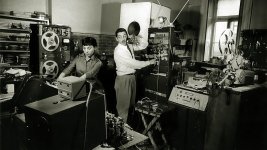We have interstellar medium, intergalactic medium and now the freshly announced space medium. Terrific. 😀The space medium is ...
I don't have a problem with zero. What would you do without it? The centre of the number line.
I was catching up more on vintage Sci-Fi films. This is MST3K giggling at "This Island Earth." The Aliens have suspiciously high foreheads.
MST3K: The Movie- Unpacking the Interocitor - YouTube
A gadget called an "Interocitor" is deployed by the aliens. The Earthlings get one through the post and start building it. 2486 parts, woops, crunch, 2485... 😀
I was catching up more on vintage Sci-Fi films. This is MST3K giggling at "This Island Earth." The Aliens have suspiciously high foreheads.
MST3K: The Movie- Unpacking the Interocitor - YouTube
A gadget called an "Interocitor" is deployed by the aliens. The Earthlings get one through the post and start building it. 2486 parts, woops, crunch, 2485... 😀
Talking about electronic gadgets in space movies...
I've come across the attached photograph which shows Bebe and Louis Barron composing the world's first all-electronic score for the Forbidden Planet soundtrack, in 1956.
I've come across the attached photograph which shows Bebe and Louis Barron composing the world's first all-electronic score for the Forbidden Planet soundtrack, in 1956.
Attachments
Last edited:
Very nice Galu but I have had this burning question on my mind year after year,(twice a year to be precise), and the time has just come up(one of them). So I'm wondering, is there an astronomical answer for why(other than circadian rhythm) there seems to be a marked change in Sun time. Not how long it actually stays up, but how bright/or dark in the case of Fall, it appears. All of a sudden in a matter of a couple days, there seems to be a sharper change than what you would logically expect or notice.😕
I've no idea what you are talking about!
I'm just glad that "the nights are fair drawin' oot", as we say in Scotland!
I'm just glad that "the nights are fair drawin' oot", as we say in Scotland!
The sun is setting at 5.30PM now. It was 4PM when I was stargazing at Christmas in Portsmouth.
All a question of time and space, about which I have made interesting discoveries. 😎
Next post please... prepare to be amazed... 🙂
All a question of time and space, about which I have made interesting discoveries. 😎
Next post please... prepare to be amazed... 🙂
OK, here it is. 😎
Quantum principle of relativity
Andrzej Dragan and Artur Ekert
Couple of lightweight articles:
A rebel physicist has an elegant solution to a quantum mystery | WIRED UK
Does relativity lie at the source of quantum exoticism?
And the proper Physics paper, which is not the hardest thing I have ever read:
Quantum principle of relativity - IOPscience
It's brilliant.
The Lorentz transformation admitting negative solutions. Just like Dirac did to discover the anti-electron from his equation.
Quantum principle of relativity
Andrzej Dragan and Artur Ekert
Couple of lightweight articles:
A rebel physicist has an elegant solution to a quantum mystery | WIRED UK
Does relativity lie at the source of quantum exoticism?
And the proper Physics paper, which is not the hardest thing I have ever read:
Quantum principle of relativity - IOPscience
It's brilliant.
6. Summary
We argue that ruling out a superluminal family of observers from special relativity, regardless whether such observers exist or not, is not necessary; it leads to a classical description of a particle moving along a well-defined single trajectory. In contrast, if one keeps both subluminal and superluminal solutions then non-deterministic behavior and non-classical motion of particles arise as a natural consequence.
The superluminal solutions appear quite naturally in general relativity. For instance a Schwarzschild solution to Einstein equations written in Schwarzschild coordinates has a peculiar property that time and radial coordinates change their metric signs at the event horizon. This is normally dismissed by arbitrarily stating that the Schwarzschild solutions only make sense above the event horizon, although written in (freely falling) Kruskal coordinates, they are smooth at the horizon. In order to resolve this puzzle we point out that Schwarzschild coordinates correspond to stationary observers placed at fixed distances from the horizon. Such observers can be subluminal only above the horizon, and under the horizon they would require superluminal motions. The sign flip in the metric therefore signifies the transition from a subluminal to a superluminal family of stationary observers residing under the event horizon in a fixed distance from the singularity.
We believe that our approach is more than a mathematical exercise and, if taken seriously, it may offer new valuable insights into deep connections between quantum theory and special relativity.
The Lorentz transformation admitting negative solutions. Just like Dirac did to discover the anti-electron from his equation.
We have interstellar medium, intergalactic medium and now the freshly announced space medium. Terrific. 😀The space medium is ...
Far out! Or should I say "Spaced out"?! 😀
I think we'd have a great time with a crate of beer and a good barbecue.
That's sooo simple, Steve.Quantum principle of relativity
It's brilliant.
Why on Earth didn't I think of it first! 🙄
In their paper (and mentioned earlier by Galu referencing Feynman) they talk about a photon taking all possible paths between its source and potential observers (let’s call them detectors for the sake of argument).
Surely this stage of affairs is best described by envisaging a single photon as radiating out from its source like a bubble. When it is detected, the photon wave function collapses to a single point, the place where it interacted with another particle. With the bubble analogy, all possible paths are included in the space between the emitter and the detector.
In this view, you can move the detector anywhere and you get the same result.
Surely this stage of affairs is best described by envisaging a single photon as radiating out from its source like a bubble. When it is detected, the photon wave function collapses to a single point, the place where it interacted with another particle. With the bubble analogy, all possible paths are included in the space between the emitter and the detector.
In this view, you can move the detector anywhere and you get the same result.
Last edited:
So, what's the difference between subluminal and superluminal?"The sign flip in the metric therefore signifies the transition from a subluminal to a superluminal family of stationary observers residing under the event horizon in a fixed distance from the singularity."
The special theory of relativity allows for three mathematically correct types of solutions:
- A world of particles moving at subluminal (sub light speed) velocities.
- A world of particles moving at the velocity of light.
- A world of particles moving at superluminal (faster than light speed) velocities.
However, the new 'quantum relativity' theory takes all three solutions seriously.
The paper suggests that a superluminal particle, as observed from a subluminal system, would look as if it were moving like a spherical wave - so there's your expanding bubble. 😎Surely this stage of affairs is best described by envisaging a single photon as radiating out from its source like a bubble.
It is pointed out that this is in accord with the famous Huygens principle which states that every point on a wavefront can be treated itself as a source of a new spherical wave.
I would imagine the bubble analogy holds for wave fronts propagating at c as well amd you can see that with the double slit experiment IIUC.
We regard four dimensional space-time as having three spatial dimensions and one time dimension.
In the new hypothesis, a superluminal particle has only one spatial dimension - the one along which it moves. The other three dimensions in which it moves appear to be time dimensions.
Whereas subluminal particles only 'age' in one time dimension, superluminal particles 'age' in three time dimensions simultaneously.
What the theorists appear to be implying is that a superluminal particle, as seen from a subluminal system, would look as if it was moving like an expanding three dimensional time bubble!
Just more mathematical manipulations that can't be imagined in terms of everyday concepts!
In the new hypothesis, a superluminal particle has only one spatial dimension - the one along which it moves. The other three dimensions in which it moves appear to be time dimensions.
Whereas subluminal particles only 'age' in one time dimension, superluminal particles 'age' in three time dimensions simultaneously.
What the theorists appear to be implying is that a superluminal particle, as seen from a subluminal system, would look as if it was moving like an expanding three dimensional time bubble!

Just more mathematical manipulations that can't be imagined in terms of everyday concepts!
- Status
- Not open for further replies.
- Home
- Member Areas
- The Lounge
- What is the Universe expanding into..


